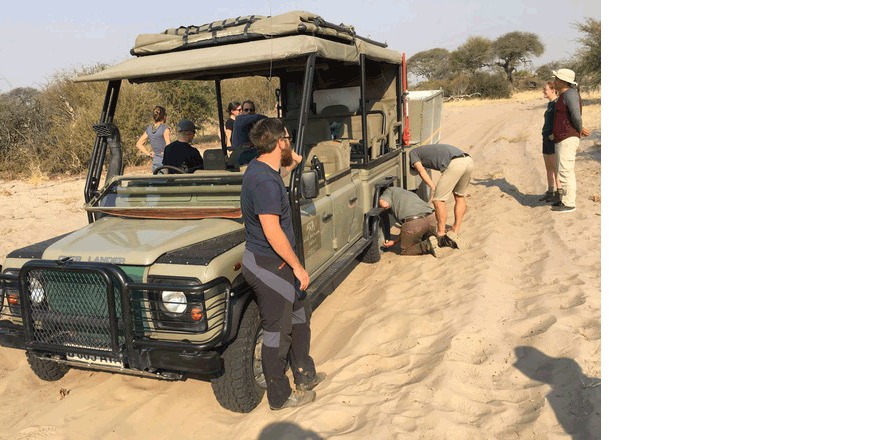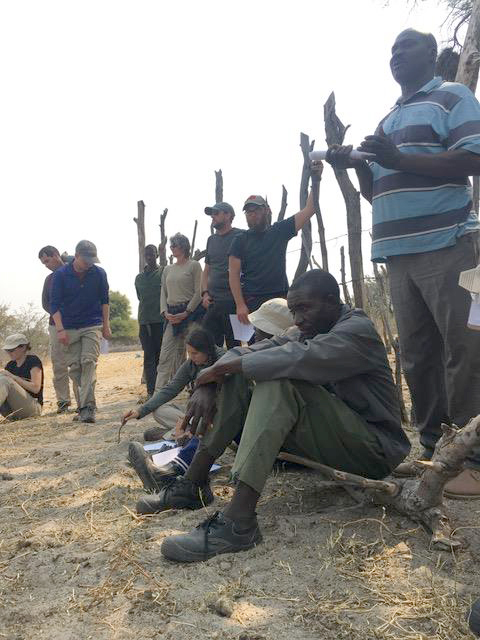Notes from the Field: Evan Humphrey - Human-Wildlife Conflict Up Close and Personal

The sun rose on our first day in Makgadikgadi National Park and even though I had received a full 10 hours of sleep I found myself glued to my bed mat. We had been in Botswana for two weeks and the fatigue of changing campsites for the fourth time had set in. We had just gotten in from Maun the previous night, late from deep sands and flat tires. While I should have been excited to see a new area I was anxious. Our mission in Makgadikgadi was to meet with the nearby community about human wildlife conflict, specifically about the conflict with lions in the town of Khumaga. I had never seen people doing actual community conversation work. I was interested to find out what it actually looked like, and I wasn’t sure I was going to like what I found.

It was mid morning as we drove into Khumaga. Picking up dust as we passed by the square lots filled with thatched-roofed huts, younng children waved and yelled with excitement as we passed. The town of Khumaga lies on the edge of the Makgadikgadi National Park. The border between the Park and the fields where cattle grazed was supposed to be separated by a fence that the government put up in 2003. But after years of pressure from wildlife and low maintenance, the fence is now littered with gaps. Wildlife from the Park have had free reign to cross over and raid, and farmers’ cattle are free to wander into the national park to eat the fertile grass around the Boteti river. Over the last few years the farmers have become less tolerant of lions killing their cattle, and some have taken to killing the lions. The government has tried to compensate farmers for their losses, but reports of lion killing have been unreliable,and local people claim the compensation is not enough. Needless to say tensions between government, community and wildlife had reached a tipping point.

When we reached the center of town we met with Jess Isden, the the director of WildCRUs human and wildlife coexistence project in both Chobi and Makgadikgadi region. She was joined her small team of local community officers who she had been working with for the last ten months. It’s been a priority for WildCRU to get people in the community involved with conversation. In the past, much of the conversation work had been done by NGOs who didn’t stay around to long to make sure their work stuck. This left the local communities in confusion and in distrust of outsiders meddling in their affairs.
The main issue that WildCRU has been tackling is the use of Kraals—traditional corral that are surrounded by thorn bush bundles—to protect cattle during the night. While they had had some success with portable kraals made of canvas, the community was still resistant. Jess took us to a small cattle post on the outskirts of town where we met the local cattle ranchers. We had the privilege of witnessing a community meeting, but if I am to be honest it was disturbing. The meeting started simple enough, Jess talked about how to fill out a report if a lion kills a cow, but soon the conversation morphed into a open forum of the ranchers discontent. The entire meeting I could feel myself tensing up, but Jess kept calm and finished the meeting on a positive note, a testament both to the skill and dedication of the people doing conservation work in this area.
As we left town I kept trying to understand my own anger, and how to turn off the negativity that persisted in my thoughts. I understood that the farmers had seen many years of government not solving their problems and fleeting NGOs, and that they wanted to continue to do things the way they always had, but there has to be a way. I wrestled with myself on how things could be different and I realized that I was angry because the change I wanted wasn’t going to happen as fast as I wanted it too. Jess had mentioned to us back on the cattle ranch that she has had the same conversation with the famers on multiple occasions, and that it takes time to solve complex problems.
I realize now that change does not come through NGOs or donations, but people, willing to give their time, their lives and their patience to people who might not want to receive it in the beginning. People who will sit down and answer the same question for the billionth time because they believe that in time there work will pay off. That one day they will look back and say that it was difficult, but it was worth every second. Conservation needs more people like this, the world needs more people like this. I have hope that over time attitudes will transform, but we can't make it happen all at once. While I don’t know if I will ever be the person who goes back into these communities and teach about conservation, I want to be a part of the change that takes time, because when it finally comes, I know it will be worth the wait.
 Evan Humphrey is a University of Illinois undergraduate majoring in Natural Resources and Environmental Science
Evan Humphrey is a University of Illinois undergraduate majoring in Natural Resources and Environmental Science



